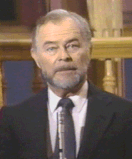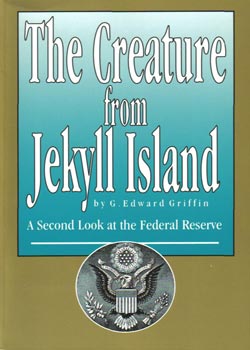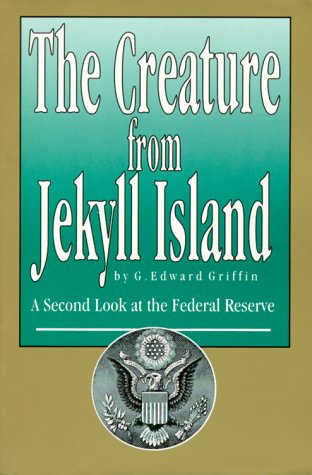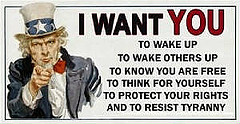The Creature From Jekyll
Island

By Prolific Author, G. Edward Griffin
(download clip you are hearing |
listen to entire presentation)
Excerpts from Chapter One specifically addressing the creation of the Federal Reserve System.
The secret meeting on Jekyll Island in Georgia at which the Federal Reserve was conceived; the birth of a banking cartel to protect its members from competition; the strategy of how to convince Congress and the public that this cartel was an agency of the United States government ...were seven men who represented an estimated one-forth of the total wealth of the entire world.
-
 Nelson W. Aldrich, Republican "whip" in the Senate, Chairman of the
National Monetary Commission, business associate of J.P. Morgan, father-in-law
to John D. Rockefeller, Jr.;
Nelson W. Aldrich, Republican "whip" in the Senate, Chairman of the
National Monetary Commission, business associate of J.P. Morgan, father-in-law
to John D. Rockefeller, Jr.; -
Abraham Piatt Andrew, Assistant Secretary of the United States Treasury;
-
Frank A. Vanderlip, president of the National City Bank of New York, the most powerful of the banks at that time, representing William Rockefeller and the international investment banking house of Kuhn, Loeb & Company;
-
Henry P. Davison, senior partner of the J.P. Morgan Company;
-
Charles D. Norton, president of J.P. Morgan's First National Bank of New York;
-
Benjamin Strong, head of J.P. Morgan's Bankers Trust Company; and
-
Paul M. Warburg, a partner in Kuhn, Loeb & Company, a representative of the Rothschild banking dynasty in England and France, and brother to Max Warburg who was head of the Warburg banking consortium in Germany and the Netherlands.
In 1913, the same year that the Federal Reserve Act was passed into law, a
subcommittee of the House Committee on Currency and Banking, under the
chairmanship of Arsene Pujo of Louisiana, completed its investigation into the
concentration of financial power in the United States. Pujo was considered to
be a spokesman for the oil interests, part of the very group under
investigation, and did everything possible to sabotage the hearings. In spite
of his efforts, however, the final report of the committee at large was
devastating. It stated:
Your committee is satisfied from the proofs submitted, even in the absence of
data from the banks, that there is an established and well defined identity
and community of interest between a few leaders of finance...which has
resulted in great and rapidly growing concentration of the control of money
and credit in the hands of these few men...
When we consider, also, in this connection that into these reservoirs of money
and credit there flow a large part of the reserves of the banks of the
country, that they are also the agents and correspondents of the out-of-town
banks in the loaning of their surplus funds in the only public money market of
the country, and that a small group of men and their partners and associates
have now further strengthened their hold upon the resources of these
institutions by acquiring large stock holdings therein, by representation on
their boards and through valuable patronage, we begin to realize something of
the extent to which this practical and effective domination and control over
our greatest financial, railroad and industrial corporations has developed,
largely within the past five years, and that it is fraught with peril to the
welfare of the country.
The purpose of this meeting on Jekyll Island was...to come to an agreement on
the structure and operation of a banking cartel. The goal of the cartel, as is
true with all of them, was to maximize profits by minimizing competition
between members, to make it difficult for new competitors to enter the field,
and to utilize the police power of government to enforce the cartel agreement.
In more specific terms, the purpose and, indeed, the actual outcome of this
meeting was to create the blueprint for the Federal Reserve System.--
The first leak regarding this meeting found its way into print in 1916. It
appeared in Leslie's Weekly and was written by a young financial reporter by
the name of B.C. Forbes, who later founded Forbes Magazine. The article was
primarily in praise of Paul Warburg, and it is likely that Warburg let the
story out during conversations with the writer. At any rate, the opening
paragraph contained a dramatic but highly accurate summary of both the nature
and purpose of the meeting:
Picture a party of the nation's greatest bankers stealing out of New York on a
private railroad car under cover of darkness, stealthily heading hundreds of
miles South, embarking on a mysterious launch, sneaking on to an island
deserted by all but a few servants, living there a full week under such rigid
secrecy that the names of not one of them was once mentioned lest the servants
learn the identity and disclose to the world this strangest, most secret
expedition in the history of American finance.
I am not romancing. I am giving to the world, for the first time, the real
story of how the famous Aldrich currency report, the foundation of our new
currency system, was written.--
In 1930, Paul Warburg wrote a massive book - 1750 pages in all - entitled "The
Federal Reserve System, Its Origin and Growth". In this tome, he described the
meeting and its purpose but did not mention either its location or the names
of those who attended. But he did say: "The results of the conference were
entirely confidential. Even the fact there had been a meeting was not
permitted to become public." Then in a footnote he added: "Though eighteen
years have since gone by, I do not feel free to give a description of this
most interesting conference concerning which Senator Aldrich pledged all
participants to secrecy."--
In the February 9, 1935, issue of the Saturday Evening Post, an article
appeared written by Frank Vanderlip. In it he said: "Despite my views about
the value to society of greater publicity for the affairs of corporations,
there was an occasion, near the close of 1910, when I was as secretive -
indeed, as furtive - as any conspirator....I do not feel it is any
exaggeration to speak of our secret expedition to Jekyll Island as the
occasion of the actual conception of what eventually became the Federal
Reserve System....We were told to leave our last names behind us. We were
told, further, that we should avoid dining together on the night of our
departure. We were instructed to come one at a time and as unobtrusively as
possible to the railroad terminal on the New Jersey littoral of the Hudson,
where Senator Aldrich's private car would be in readiness, attached to the
rear end of a train for the South....
Once aboard the private car we began to observe the taboo that had been fixed
on last names. We addressed one another as "Ben," "Paul," "Nelson," "Abe" - it
is Abraham Piatt Andrew. Davison and I adopted even deeper disguises,
abandoning our first names. On the theory that we were always right, he became
Wilbur and I became Orville, after those two aviation pioneers, the Wright
brothers....The servants and train crew may have known the identities of one
or two of us, but they did not know all, and it was the names of all printed
together that would have made our mysterious journey significant in
Washington, in Wall Street, even in London. Discovery, we knew, simply must
not happen, or else all our time and effort would be wasted.
If it were to be exposed publicly that our particular group had got together
and written a banking bill, that bill would have no chance whatever of passage
by Congress.--
As with all cartels, it had to be created by legislation and sustained by the
power of government under the deception of protecting the consumer.--
As John Kenneth Galbraith explained it:
"It was his [Aldrich's] thought to outflank the opposition by having not one
central bank but many. And the word bank would itself be avoided."--Galbraith
says "...Warburg has, with some justice, been called the father of the
system."
Professor Edwin Seligman, a member of the international banking family of J. &
W. Seligman, and head of the Department of Economics at Columbia University,
writes that "...in its fundamental features, the Federal Reserve Act is the
work of Mr. Warburg more than any other man in the country."--
Another brother, Max Warburg, was the financial adviser of the Kaiser and
became Director of the Reichsbank in Germany. This was, of course, a central
bank, and it was one of the cartel models used in the construction of the
Federal Reserve System. The Reichsbank, incidentally, a few years later would
create the massive hyperinflation that occurred in Germany, wiping out the
middle class and the entire German economy as well.--
...A. Barton Hepburn of Chase National Bank was even more candid. He said:
"The measure recognizes and adopts the principles of a central bank. Indeed,
if all works out as the sponsors of the law hope, it will make all
incorporated banks together joint owners of a central dominating power." And
that is about as good a definition of a cartel as one is likely to find.--
...it is incapable of achieving its stated objectives.--
...why is the System incapable of achieving its stated objectives?
The painful answer is: those were never its true objectives.--
Anthony Sutton, former Research Fellow at the Hoover Institution for War,
Revolution and Peace, and also Professor of Economics at California State
University, Los Angeles, provides a somewhat deeper analysis. He writes:
"Warburg's revolutionary plan to get American Society to go to work for Wall
Street was astonishingly simple. Even today,...academic theoreticians cover
their blackboards with meaningless equations, and the general public struggles
in bewildered confusion with inflation and the coming credit collapse, while
the quite simple explanation of the problem goes undiscussed and almost
entirely uncomprehended. The Federal Reserve System is a legal private
monopoly of the money supply operated for the benefit of the few under the
guise of protecting and promoting the public interest.--"
The real significance of the journey to Jekyll Island and the creature that
was hatched there was inadvertently summarized by the words of Paul Warburg's
admiring biographer, Harold Kellock:
"Paul M. Warburg is probably the mildest-mannered man that ever personally
conducted a revolution. It was a bloodless revolution: he did not attempt to
rouse the populace to arms. He stepped forth armed simply with an idea. And he
conquered. That's the amazing thing. A shy, sensitive man, he imposed his idea
on a nation of a hundred million people.--"
"G. Edward Griffin exposes the most blatant scam of all history. Itís all here: the cause of wars, boom-bust cycles, inflation, depression, prosperity. It's just exactly what every American needs to know about the power of the central bank." END
Click Here to order this book from REALITY ZONE.This book exposes the diabolic evil Federal Reserve System and how it all began.



